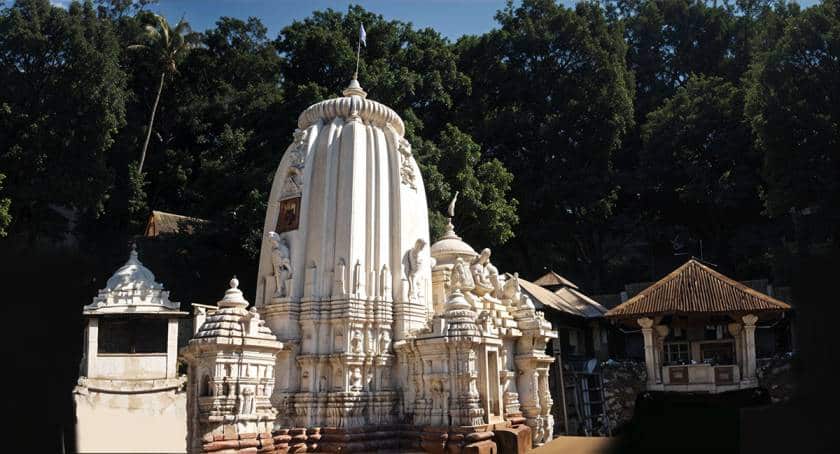Kapilash Temple, Odisha
Kapilash Temple, located in Odisha’s Dhenkanal district, is a revered Hindu pilgrimage site committed to Lord Shiva. The temple sits atop Kapilash Hill at 2,239 feet, and devotees believe it to be the mythical Kailash, Lord Shiva’s abode. Devotees climb 1,352 steps or take a motorable road to reach the shrine. The temple, built in the 13th century, showcases Kalinga-style architecture. A key attraction is the annual Maha Shivaratri festival, drawing thousands of devotees. The site also features ancient monasteries, scenic views, and spiritual tranquility, making it a significant cultural landmark.
Mythological Legends and Spiritual Significance
Kapilash Temple is associated with several legends, making it an important pilgrimage site. One of the most prominent myths suggests that this temple is the abode of Lord Chandrasekhara, a form of Lord Shiva. Many believe that Kapilash was the ashram of Sage Kapila, from whom the hill and the temple derive their name. The presence of the sage in this sacred region is said to have infused the land with divine energy, making it a center of spiritual enlightenment.
Another legend links this place with the Mahabharata. It states that the Pandavas spent some time here during their exile. During their stay, they sought blessings from Lord Shiva, and their presence enhanced the sanctity of the place. Devotees and scholars strongly feel the divine vibrations at Kapilash Temple.
The temple is known as the “Kashi of Odisha,” emphasizing its immense spiritual importance. Pilgrims from across the country visit this shrine to seek blessings, absolve their sins, and experience spiritual rejuvenation.
Architectural Masterpiece of Kapilash Temple
A magnificent example of Kalinga-style architecture, Kapilash Temple is renowned for its elaborate carvings and magnificence. The temple showcases superb artistry and structural quality, reflecting the traditional Odisha architectural style in which builders constructed it. Some key highlights of the temple’s architecture include:
- The Main Temple Tower (Deula): The temple’s towering structure, approximately 60 feet tall, is adorned with sculptural embellishments depicting stories from Hindu mythology. The temple’s design is reminiscent of the Lingaraja Temple in Bhubaneswar, reinforcing its architectural grandeur.
- The Stone Staircase: The entrance to the temple has a stone staircase with 1,352 steps, leading devotees to the sanctum sanctorum. Climbing these steps, which represent the spiritual path to enlightenment, embodies an act of penance and devotion.
- The Sanctum Sanctorum: This intricately carved sanctum houses the Shiva Lingam, where devotees and priests perform daily rituals and prayers. It exudes a serene and divine aura, attracting worshippers seeking peace and blessings.
- The Rajprasad (King’s Palace): Located near the temple, this palace supposedly served as a residence for ancient rulers during their visits. Its presence highlights how royal patrons historically valued Kapilash.
- Smaller Shrines and Other Structures: The temple complex also includes smaller shrines dedicated to various Hindu deities, further emphasizing its religious and historical significance. These shrines allow devotees to offer prayers to different gods and goddesses.
Grand Festivals and Celebrations
Kapilash Temple is a hub of grand celebrations, especially during:
- Maha Shivaratri: Devotees enthusiastically celebrate the most significant festival at Kapilash. They observe fasting, chant mantras, and perform night-long prayers. Lamps illuminate the temple premises, creating a divine atmosphere.
- Kartik Purnima: A sacred occasion for devotees who visit the temple to seek divine blessings. Rituals and special prayers mark this day, attracting thousands of pilgrims.
- Shravan Month: The entire month of Shravan (July-August) witnesses an influx of pilgrims performing Jalabhishek (offering water) to Lord Shiva. Many people consider the Mondays of this month especially auspicious for worshiping Lord Shiva.
During these festivals, devotees decorate the temple beautifully, and priests and participants conduct spiritual activities like bhajans and discourses. The festive atmosphere fills the air with devotion and joy, making these occasions an unforgettable experience for visitors.
The Natural Beauty Surrounding Kapilash Temple
The temple is a religious landmark and a nature lover’s paradise. The area bordering the temple features hills and dense forests that host various plant and animal species. The serene ambiance makes it a perfect place for meditation and relaxation. Additionally, visitors can take expansive views of the surroundings from the temple grounds. The hills around the temple showcase a rich biodiversity, making the region a haven for wildlife enthusiasts and nature photographers.
For those seeking solace, the peaceful environment of Kapilash Temple provides an ideal setting for spiritual contemplation. Many sages and monks have meditated in the caves and forests surrounding the temple, adding to its mystic charm.
Best Time to Visit
The ideal time to visit Kapilash Temple is during the winter months (October to March) when the weather is pleasant and suitable for climbing the steps. Visiting Maha Shivaratri is an excellent choice if you want to witness the grand celebrations.
Final Thoughts
Kapilash Temple symbolizes devotion, history, and natural beauty. This temple has something to offer everyone, whether you are a devoted pilgrim, an admirer of architecture, or a lover of the outdoors. Its mythological significance, grand architecture, and serene surroundings make it one of Odisha’s most cherished spiritual destinations.
The temple’s location in the hills provides a divine retreat and an opportunity to explore Odisha’s scenic beauty. A visit to Kapilash Temple is a journey into the past, offering a glimpse into the region’s rich cultural heritage and spiritual traditions.
So, if you seek divine blessings or simply wish to explore India’s cultural and architectural grandeur, visiting Kapilash Temple is a worthwhile journey. The temple is a must-visit location for those seeking spirituality and calm because of its devotion, history, and stunning natural beauty.


